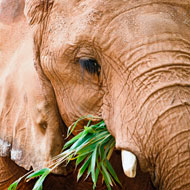
Findings will be used to shape major policy decisions
A continent-wide survey has revealed a huge decline in the number of African Savannah elephants.
Final results from The Great Elephant Census (GEC) show 352,271 African Savannah elephants in 18 countries - a fall of 30 per cent in just seven years.
Furthermore, the survey found that populations are shrinking eight per cent continent-wide, primarily due to poaching.
Announcing the news at the IUCN World Conservation Congress, project organiser Paul G Allen described the results as 'deeply disturbing'.
“This was an extraordinary collaboration across borders, cultures and jurisdictions. We completed a successful survey of massive scale, and what we learned is deeply disturbing," he said.
"Armed with this knowledge of dramatically declining elephant populations, we share a collective responsibility to take action and we must all work to ensure the preservation of this iconic species.”
African elephants are at risk from poaching and habitat loss. Despite global attention to the plight of elephants, their population size and trends were, until now, uncertain.
Launched in December 2013, the census involved 81 aeroplanes and 286 crew members flying roughly 463,000 kilometres to complete the survey.
Working with lead NGO Elephants Without Borders, Mr Allen's project also included 90 scientists, a technical advisory group and a host of other NGO partners.
As well as discovering that elephant numbers have declined by 30 per cent, the survey found high numbers of elephant carcases in many protected areas. This indicates that elephants are struggling both inside and outside parks.
The report will be published in advance of the 17th meeting of the Conference of the Parties to CITES in Johannesburg, South Africa and will be used to shape major policy decisions about the future of elephants.



 BSAVA is to partner with BVA Live (11-12 June 2026) to champion clinical research.
BSAVA is to partner with BVA Live (11-12 June 2026) to champion clinical research.